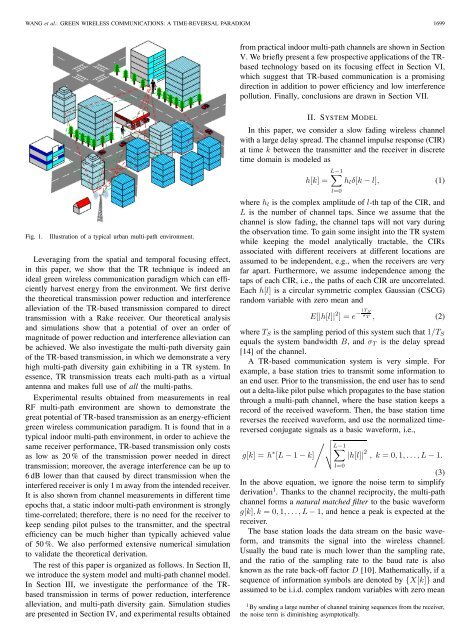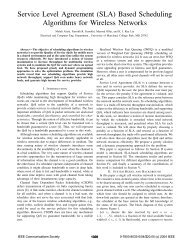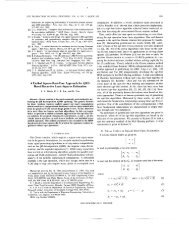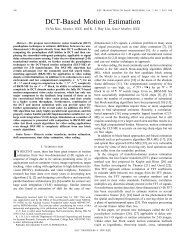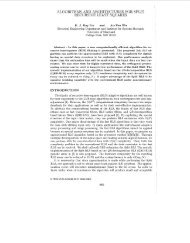Green Wireless Communications: A Time-Reversal Paradigm
Green Wireless Communications: A Time-Reversal Paradigm
Green Wireless Communications: A Time-Reversal Paradigm
You also want an ePaper? Increase the reach of your titles
YUMPU automatically turns print PDFs into web optimized ePapers that Google loves.
WANG et al.: GREEN WIRELESS COMMUNICATIONS: A TIME-REVERSAL PARADIGM 1699<br />
from practical indoor multi-path channels are shown in Section<br />
V. We briefly present a few prospective applications of the TRbased<br />
technology based on its focusing effect in Section VI,<br />
which suggest that TR-based communication is a promising<br />
direction in addition to power efficiency and low interference<br />
pollution. Finally, conclusions are drawn in Section VII.<br />
Fig. 1.<br />
Illustration of a typical urban multi-path environment.<br />
Leveraging from the spatial and temporal focusing effect,<br />
in this paper, we show that the TR technique is indeed an<br />
ideal green wireless communication paradigm which can efficiently<br />
harvest energy from the environment. We first derive<br />
the theoretical transmission power reduction and interference<br />
alleviation of the TR-based transmission compared to direct<br />
transmission with a Rake receiver. Our theoretical analysis<br />
and simulations show that a potential of over an order of<br />
magnitude of power reduction and interference alleviation can<br />
be achieved. We also investigate the multi-path diversity gain<br />
of the TR-based transmission, in which we demonstrate a very<br />
high multi-path diversity gain exhibiting in a TR system. In<br />
essence, TR transmission treats each multi-path as a virtual<br />
antenna and makes full use of all the multi-paths.<br />
Experimental results obtained from measurements in real<br />
RF multi-path environment are shown to demonstrate the<br />
great potential of TR-based transmission as an energy-efficient<br />
green wireless communication paradigm. It is found that in a<br />
typical indoor multi-path environment, in order to achieve the<br />
same receiver performance, TR-based transmission only costs<br />
as low as 20 % of the transmission power needed in direct<br />
transmission; moreover, the average interference can be up to<br />
6 dB lower than that caused by direct transmission when the<br />
interfered receiver is only 1 m away from the intended receiver.<br />
It is also shown from channel measurements in different time<br />
epochs that, a static indoor multi-path environment is strongly<br />
time-correlated; therefore, there is no need for the receiver to<br />
keep sending pilot pulses to the transmitter, and the spectral<br />
efficiency can be much higher than typically achieved value<br />
of 50 %. We also performed extensive numerical simulation<br />
to validate the theoretical derivation.<br />
The rest of this paper is organized as follows. In Section II,<br />
we introduce the system model and multi-path channel model.<br />
In Section III, we investigate the performance of the TRbased<br />
transmission in terms of power reduction, interference<br />
alleviation, and multi-path diversity gain. Simulation studies<br />
are presented in Section IV, and experimental results obtained<br />
II. SYSTEM MODEL<br />
In this paper, we consider a slow fading wireless channel<br />
with a large delay spread. The channel impulse response (CIR)<br />
at time k between the transmitter and the receiver in discrete<br />
time domain is modeled as<br />
L−1<br />
∑<br />
h[k] = h l δ[k − l], (1)<br />
l=0<br />
where h l is the complex amplitude of l-th tap of the CIR, and<br />
L is the number of channel taps. Since we assume that the<br />
channel is slow fading, the channel taps will not vary during<br />
the observation time. To gain some insight into the TR system<br />
while keeping the model analytically tractable, the CIRs<br />
associated with different receivers at different locations are<br />
assumed to be independent, e.g., when the receivers are very<br />
far apart. Furthermore, we assume independence among the<br />
taps of each CIR, i.e., the paths of each CIR are uncorrelated.<br />
Each h[l] is a circular symmetric complex Gaussian (CSCG)<br />
random variable with zero mean and<br />
E[|h[l]| 2 ]=e − lT S<br />
σ T , (2)<br />
where T S is the sampling period of this system such that 1/T S<br />
equals the system bandwidth B, andσ T is the delay spread<br />
[14] of the channel.<br />
A TR-based communication system is very simple. For<br />
example, a base station tries to transmit some information to<br />
an end user. Prior to the transmission, the end user has to send<br />
out a delta-like pilot pulse which propagates to the base station<br />
through a multi-path channel, where the base station keeps a<br />
record of the received waveform. Then, the base station time<br />
reverses the received waveform, and use the normalized timereversed<br />
conjugate signals as a basic waveform, i.e.,<br />
/ √ √√<br />
L−1<br />
∑<br />
g[k] = h ∗ [L − 1 − k] |h[l]| 2 ,k=0, 1,...,L− 1.<br />
l=0<br />
(3)<br />
In the above equation, we ignore the noise term to simplify<br />
derivation 1 . Thanks to the channel reciprocity, the multi-path<br />
channel forms a natural matched filter to the basic waveform<br />
g[k],k =0, 1,...,L− 1, and hence a peak is expected at the<br />
receiver.<br />
The base station loads the data stream on the basic waveform,<br />
and transmits the signal into the wireless channel.<br />
Usually the baud rate is much lower than the sampling rate,<br />
and the ratio of the sampling rate to the baud rate is also<br />
known as the rate back-off factor D [10]. Mathematically, if a<br />
sequence of information symbols are denoted by {X[k]} and<br />
assumed to be i.i.d. complex random variables with zero mean<br />
1 By sending a large number of channel training sequences from the receiver,<br />
the noise term is diminishing asymptotically.


